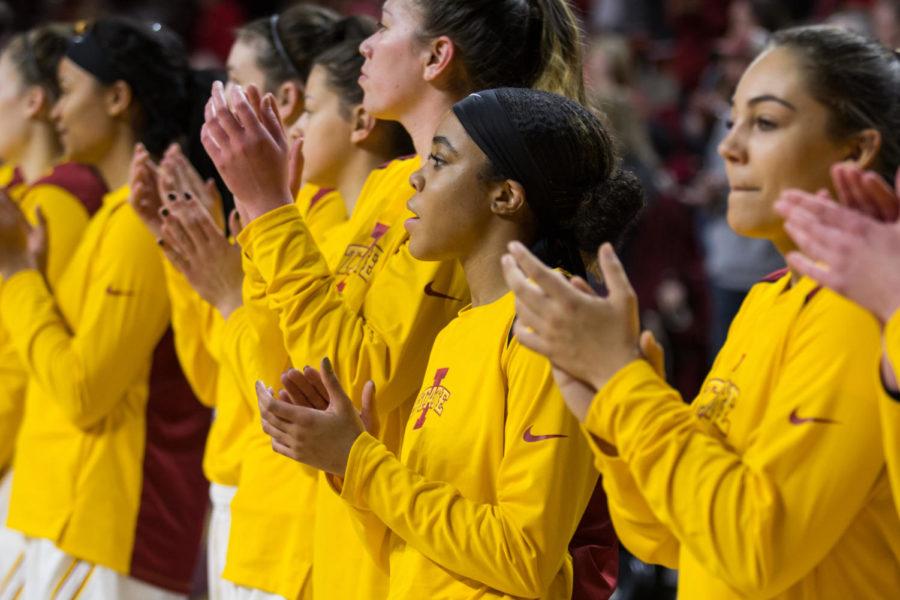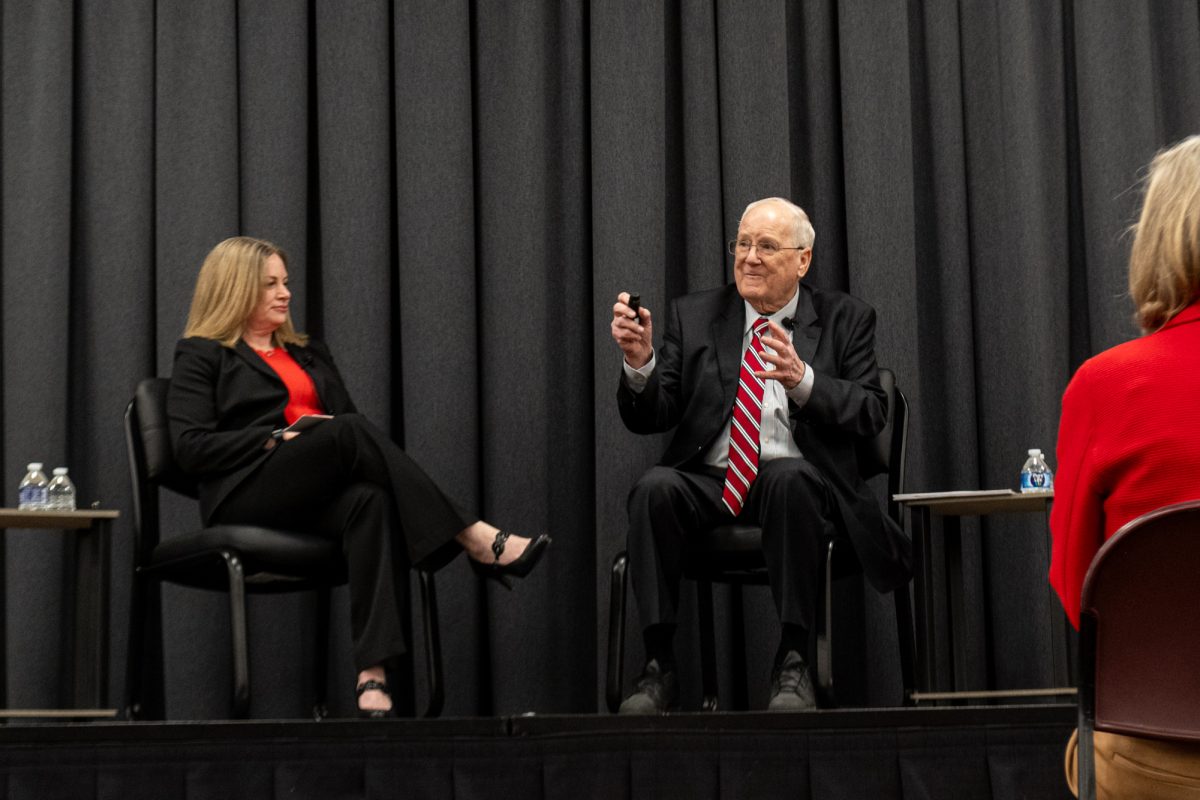Iowa State women’s basketball analysis: Three key areas for the Cyclones in 2018
January 2, 2018
The 2018 year has begun, and with it comes a challenging Big 12 schedule.
It’s been a mixed season so far for the Iowa State women’s basketball team. After a non-conference schedule rife with frustrating performances and moments of great promise, the Cyclones will need to put up a string of solid performances to have any hopes of getting an at-large bid in the NCAA Tournament. The Cyclones are off to a 1-1 start, with an overtime victory over Kansas and a close loss to Oklahoma already in the books.
Heading into a difficult stretch of games, there are three main areas the Cyclones must perform well in to be successful in conference play.
The 3-Point Line
Iowa State has to shoot the ball well from 3-point range.
Coach Bill Fennelly knows this fact all too well.
“We don’t have a great low block presence,” Fennelly said. “It’s about 3-point shooting, spreading the court.
“We have a lot of kids who can make it.”
The Cyclones are currently fourth in 3-point percentage in the Big 12, shooting 35.9 percent on the season. Iowa State has four players shooting better than 35 percent on 35-plus attempts, and junior center Bride Kennedy-Hopoate has hit 5-of-14 3-pointers, including three of her last four.
When the 3-point shot is working, Iowa State can seem dynamic, scoring points in bunches and frustrating opposing defenses. With Kennedy-Hopoate on the floor at center, the Cyclones have at times gone five-out with a drive-and-kick mentality. That ability to stretch the floor from the center position creates mismatches that the Cyclones can exploit.
Junior forward Meredith Burkhall explained what gets opposing bigs out of the lane.
“Not being afraid to shoot the ball and take a step out,” Burkhall said. “Getting their five man on the move is a big key.”
That spacing also enhances junior guard Bridget Carleton’s ability to frustrate defenses. If opposing defenses have to consistently worry about the kick-out to a 3-point shooter, then lanes to the basket will open up for Carleton or other guards to drive and get points in the paint.
But when Iowa State misses its threes, like on Sunday against Oklahoma (when the Cyclones shot 7-for-28), the offense becomes stunted and often finds it difficult to create points. The Sooner’s strategy of running Iowa State hard off screens is now on tape and the Cyclones will have to find a way to adjust in the coming weeks.
Improved Defensive Flexibility
Often times, teams have one specific defensive identity and stick to their approach.
Fennelly is trying to mix things up with this year’s Cyclones.
“Every game is about experimenting with matchups,” Fennelly said. “We have to think outside the box a little bit.”
Iowa State ranks toward the bottom of the Big 12 in multiple defensive categories, ranking seventh in opponent field goal percentage and ninth in steals per game. Iowa State has been blocking shots at a surprising rate, ranking third in the Big 12 with an average of 5.8 blocks per game. Freshman center Kristin Scott leads the Cyclones with 15 blocks on the season, but in recent games Bridget Carleton and Madison Wise have stepped up with blocked shots of their own.
Iowa State defenses under Fennelly have often not forced turnovers at a high rate, and this season’s team is ninth in the Big 12, only forcing 14.8 turnovers per game. However, that is a big step up from the 2016-17 season, when the Cyclones only forced 13.1 turnovers per contest. Part of that growth is the increased usage of the 2-3 zone.
“We’ve played a little more zone against size,” Fennelly said. “We’re a team that has to be a little more versatile.”
The Cyclones have frequently mixed in a 2-3 zone defense this season, and they’ve also incorporated wrinkles within that defense for specific matchups, most notably in the Cy-Hawk game in early December.
Iowa State set out to limit the impact of star center Megan Gustafson by using Carleton in the middle of the zone, constantly fronting Gustafson with help from a post player behind, effectively cutting her supply chain. Gustafson only took two shots in the first half.
Entering a stretch of games against physical teams with dominant center play in Baylor and West Virginia, Iowa State will have to continue to surprise opponents on the defensive end to account for bad matchups.
Better Ball Movement
This was always going to be an issue with the point guard conundrum the Cyclones have found themselves in. Without a true point guard on the roster aside from sophomore Nia Washington, it’s difficult to create chances offensively with a base offense. The Cyclones had big struggles early on in the season, at one point having a 2-to-1 turnover to assist ratio.
Five-star 2018 commit Ashley Joens will go a long way towards solving the point guard issues for Iowa State, but with two months still left in this season, the Cyclones have been trying to find a way to spread the ball around to combat the high-quality Big 12 defenses that await them.
Iowa State has tried multiple solutions to this problem, with mixed success. Emily Durr has been at the starting point guard spot for most of the season, averaging 3.8 assists per game to rank second on the team.
Freshman guard Rae Johnson has started a game and has been the main point guard for the second unit, although she’s only averaging 2.2 assists per outing. Against Missouri-Kansas City, Fennelly even started Carleton at the point (it went poorly, as Carleton had three assists and seven turnovers).
Eighth in the Big 12 in assists per game (14.5), Iowa State has only had four games with over 15 assists. In their first two conference games, the Cyclones have mustered only 21 total assists and 31 turnovers.
Johnson wants to be the solution at point guard, and she knows that improving in practice is huge.
“Practice is a big part of the game,” Johnson said. “The coaches have been helping me with creating [on offense].”
Heading into 2018, the Cyclones have decisions to make and room to grow to become a top-half Big 12 team. In such a cutthroat conference, though, the margin for error is razor-thin.






